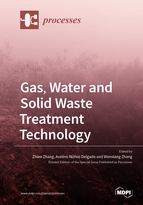Gas, Water and Solid Waste Treatment Technology
A special issue of Processes (ISSN 2227-9717). This special issue belongs to the section "Environmental and Green Processes".
Deadline for manuscript submissions: closed (31 December 2020) | Viewed by 137495
Special Issue Editors
Interests: gas separation; CO2 capture; polymeric membrane; membrane separation; membrane contactor; membrane absorption; modeling; membrane preparation; membrane characterization
Special Issues, Collections and Topics in MDPI journals
Interests: adsorption-desorption; diffuse source pollution; microbial contamination in environmental compartments; soil degradation; soil pollution; soil remediation; soil restoration; sorption of pollutants; waste treatment; waste recycling; wastewater treatment
Special Issues, Collections and Topics in MDPI journals
Special Issue Information
Dear Colleagues,
Environmental pollution, including gas pollution, water pollution, and solid waste pollution, are the main social and environmental problems. A variety of treatment technologies, such as physical, chemical, and biological methods, have been used for the treatment of the pollutants. However, there are still information gaps in the fields of treatment processes for gas emissions, wastewater, and solid waste. Herein, we are inviting scholars to submit original research articles, technical notes, and review articles in a broad range of topics for the Special Issue on “Gas, Water, and Solid Waste Treatment Technology”. Experimental and modeling works and life cycle assessment (LCA) or techno-economic analysis (TEA) focused on pollutant treatment processes using emerging and novel technologies in a wide variety of application fields as well as reviews on the recent advances are highly welcome.
Dr. Zhien Zhang
Prof. Dr. Avelino Núñez-Delgado
Dr. Wenxiang Zhang
Guest Editors
Manuscript Submission Information
Manuscripts should be submitted online at www.mdpi.com by registering and logging in to this website. Once you are registered, click here to go to the submission form. Manuscripts can be submitted until the deadline. All submissions that pass pre-check are peer-reviewed. Accepted papers will be published continuously in the journal (as soon as accepted) and will be listed together on the special issue website. Research articles, review articles as well as short communications are invited. For planned papers, a title and short abstract (about 100 words) can be sent to the Editorial Office for announcement on this website.
Submitted manuscripts should not have been published previously, nor be under consideration for publication elsewhere (except conference proceedings papers). All manuscripts are thoroughly refereed through a single-blind peer-review process. A guide for authors and other relevant information for submission of manuscripts is available on the Instructions for Authors page. Processes is an international peer-reviewed open access monthly journal published by MDPI.
Please visit the Instructions for Authors page before submitting a manuscript. The Article Processing Charge (APC) for publication in this open access journal is 2400 CHF (Swiss Francs). Submitted papers should be well formatted and use good English. Authors may use MDPI's English editing service prior to publication or during author revisions.
Keywords
- Pollutant treatment
- Gas emission
- Wastewater
- Solid waste
- Waste-to-energy
- Life cycle assessment
- Technoeconomic analysis
- Modeling








